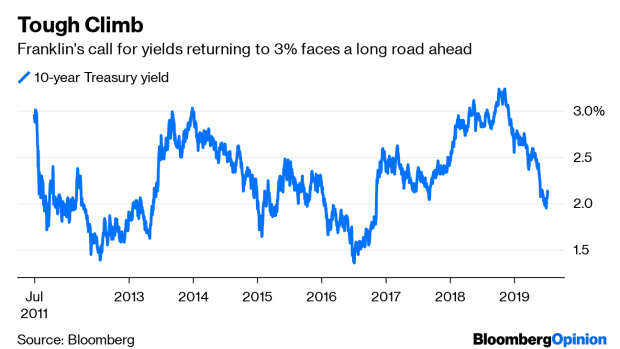Jul 12, 2019
U.S. Yields at 3%? Franklin’s Making Too Much Sense
, Bloomberg News

(Bloomberg Opinion) -- No one can accuse Franklin Templeton’s top bond managers of lacking conviction when it comes to their bearish call on U.S. Treasuries.
Earlier this year, Michael Hasenstab shortened the average duration in his Templeton Global Bond Fund to -2.21 years, from -1.6 years at the end of 2018, even though the benchmark 10-year Treasury yield fell about 30 basis points over the first three months of 2019. The fund will probably release its second-quarter documents soon. Don’t expect them to show the firm has thrown in the towel on bets for higher yields, judging by recent comments from Sonal Desai, chief investment officer of Franklin Templeton’s $152 billion fixed-income group.
Bloomberg News’s Vivien Lou Chen caught up with Desai to get her latest perspective after Federal Reserve Chair Jerome Powell effectively locked in a July interest-rate cut. Here’s a recap:
While much of the Wall Street crowd sees a decline in yields, [Desai] believes Treasury 10-year rates could jump toward 3% by year-end from just above 2% now. That should happen as a stream of solid reports prompts a swift reappraisal by investors of the economy’s health, she said.
...
“Can the 10-year yield get to 2.50%, 2.60%, 2.75% this year? Why not?” she said. The economy is in “incredibly good health,” she added, pointing to the better-than-estimated 224,000 jump in U.S. payrolls in June. Desai is finding “select” opportunities in U.S. corporate debt rated triple B that will do well under a scenario of rising yields.
Throughout the article, Desai makes perfectly valid assessments. She expects the Fed will lower rates this month even though the more “sensible” approach would be to remain on hold. The central bank is “continuing to cave to markets pressure by not looking at the data.” One reason yields will climb back toward 3% is because “markets will realize that the economy is as strong as it was last November, when 10-year yields were above 3%,” plus the Fed will be easing policy this time around.
Problem is, this sort of logic no longer seems to apply to bond markets.
Consider the following. Germany this week issued 10-year debt that doesn’t pay interest, and at a price higher than the principal it’ll pay back at maturity in 2029. Investors lined up to buy 50-year Italian securities at a yield of less than 3%. They’re willing to buy Austrian century bonds at 1.17% and also 100-year obligations from Argentina and Mexico. Some junk-rated European corporate bonds had sub-zero yields at one point. Perhaps my Bloomberg Opinion colleague Marcus Ashworth put it best: “Investors are in a very weird place.”
Against this sort of backdrop, it’s hard to be overly bearish on Treasuries. Desai is correct that the U.S. labor market is strong, but at the same time Powell bluntly said during Congressional testimony this week that the June jobs report didn’t change his mind at all about the need to lower interest rates at month-end. His go-to line was that global growth was at risk of slowing. Even though it might very well be more prudent to keep interest rates steady based on U.S. data alone, it’s now abundantly clear that the Fed feels the need to act as a more global central bank. To do that, interest rates must move lower, with the only question being just how far they’ll fall.
Of course, that doesn’t mean bonds won’t have their ups and downs. Indeed, 10-year U.S. yields have climbed almost 10 basis points this week, the steepest increase since early March. Thirty-year yields are up the most since November after a poor $16 billion auction on Thursday and consumer price index data beat expectations. Any sort of sustained jump in inflation would surely pressure long rates higher, though history has shown the Fed has struggled to ramp up the pace of price growth through monetary easing.
Those sorts of blips still don’t get 10-year Treasury yields to 3% again. Crucially, that level is now barely seen as within the realm of possibility, meaning investors will likely fall over themselves to buy on any sell-off. A Bloomberg survey of 60 analysts released Friday showed that all but one respondent saw the 10-year yield ending 2019 at 2.5% or less. Only John Dunham at Guerrilla Economics and Stephen Stanley at Amherst Pierpont Securities see the yield reaching 3% by year-end 2020. It’s true that these forecasts are often volatile and chase market prices, but they’re useful to assess the generally accepted path forward for interest rates.
There’s nothing wrong with Franklin taking a contrarian stance on the direction of interest rates. There are two sides to every market, after all. But to not recognize that the game has changed in the global bond market in recent months risks veering from contrarianism to sheer stubbornness.
To contact the author of this story: Brian Chappatta at bchappatta1@bloomberg.net
To contact the editor responsible for this story: Beth Williams at bewilliams@bloomberg.net
This column does not necessarily reflect the opinion of the editorial board or Bloomberg LP and its owners.
Brian Chappatta is a Bloomberg Opinion columnist covering debt markets. He previously covered bonds for Bloomberg News. He is also a CFA charterholder.
©2019 Bloomberg L.P.